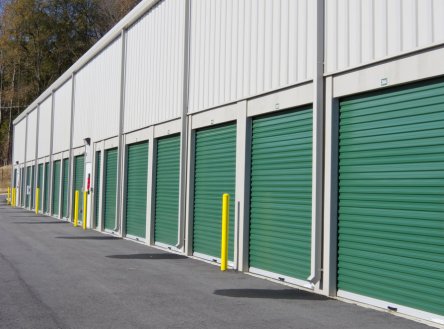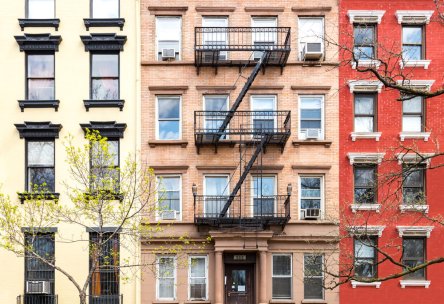Here are some key findings in the most recent U.S. office property report from Yardi® Matrix. All figures are as of October 2019 unless otherwise noted. Demand for office space remains strong, with office-using sectors adding 545,000 jobs over the past 12 months. One of every three jobs added in the 12 months ending in September were in office-using sectors. The average U.S. office asking rate increased 2% year-over-year. Per-square-foot prices for central business district buildings are 24.6% higher than in 2018. Prices for buildings with A+ and A ratings have increased 12.1% this year. Markets with the highest year-over-year listing rate growth were San Francisco, Tampa, Fla., the San Francisco Bay Area and Manhattan. N.Y. The national vacancy rate increased 40 basis points from the previous month, to 13.7%. Lower interest rates have helped accelerate transaction activity since the summer, with investment volume totaling $74 billion. Office space delivered nationally totaled 59.2 million square feet. 1 million square feet of space is under construction. Get all the details in the Yardi Matrix national office report for November...
A Match Made in Heaven
Self Storage + Multifamily Housing
The 2020 NMHC & Kingsley Apartment Resident Preferences Survey reports that 71 percent of rural renters and 70 percent of suburban renters ranked “additional storage outside apartment” as a top interest. Many multifamily properties, however, are not equipped with storage units for renters. Self-storage facility managers can fill the gap and benefit from a steady stream of clientele—if you make the right connections. Make an offer they can’t refuse Before the turn of the millennium, additional storage wasn’t as in-demand then as it is now. As a result, many older properties weren’t constructed with storage units for renters. Even some newer properties with storage options don’t have enough to meet demand. Such properties may prove to be your valuable partners. Renters who need storage may find the additional space they need at self storage facilities in the neighborhood. The challenge is to make sure that your storage facility tops their list. You could amplify your online marketing strategy, but that could be costly and time consuming. A captive audience, through a partnership with local apartment communities, could be a much surer path to success. Think about negotiating an incentive or deal for residents in nearby apartment communities. You’re interested in predictable, long-term clients. Multifamily agents want to meet prospects’ and renters’ demands for storage space outside of the unit. There is room for both parties to benefit. “Consider approaching the apartment community with a win-win proposal without a formal monetary reward if there is not another competing storage property within proximity. Pitch your storage property as a neighborhood amenity that the community manager can promote. Only offer a referral bonus if competition forces you to do so,” advises Mark Smith, Director of Marketing with Yardi. He continues, “Storage operators should consider (and continually re-evaluate) their new customer acquisition costs. Make sure that your referral bonus agreement with an apartment community is in line with your normal acquisition costs.” Benefit from verified clients Most multifamily properties vet their residents before allowing them to sign a lease. A verification of employment history, good credit standing, and background checks are quite common. In contrast, very few self-storage facilities require an in-depth approval process. When you create a relationship with an apartment community, you can benefit from their verification process. Multifamily renters go through additional steps that could in turn reduce your exposure to missed payments and other risks. You will still benefit, though, from your own due diligence. “Track all tenants that rented via referral programs and evaluate for ROI,” says Smith. “Are they tenants that have paid their bills and stayed long enough to provide a positive revenue stream, or are you better off terminating the agreement with the apartment community?” Put your best foot forward To secure your position as their preferred vendor, clearly detail what differentiates you from the competition. You then have a platform to confidently state your price because you have demonstrated the value that you can offer to their renters. There are a few key features that renters want in off-site storage. If you offer such features, be sure to highlight them in your proposal: Security In an ideal world, renters would safely store their belongings in their apartment. But with limited space, that isn’t an option. They rely on you to provide additional space that is also secure. Keyless access via a smartphone app or personalized keycodes are popular with renters. (Some use similar technology to access their apartments.) By implementing such tech, you can offer a secure way to access units without the burdens and risks of physical keys. Most renters expect security cameras and gated entry. Offering 24/7 staff availability (or at least extended office hours) adds an appealing layer of security and reassurance during emergencies or other issues. Ease of Use While renters want secure self-storage, they want to access it on demand. This is another place where keyless entry places you...
Multifamily Rolls On
Yardi Matrix Update
The latest Yardi® Matrix U.S. multifamily market update illustrates good overall performance in the sector, with strong demand, steady new supply and consistent rent growth among the key characteristics. Demand for multifamily housing, driven by rising divorce rates, an aging population, and young people delaying marriage and raising children, figures to remain strong for the foreseeable future. Much of the economic growth powering demand is occurring in Southern and Western regions. Meanwhile, national supply growth can be expected to remain in line with 2018 deliveries for the next few years. The webinar update, conducted by Jeff Adler, Yardi Matrix vice president and general manager, and Jack Kern, director of research and publications, also debuted Yardi Matrix’s structured examination of political risk as an investment factor. The analysis weighs a metro’s affordability, philosophy toward affordability (e.g., rent control, zoning policies, permitting and entitlement requirements), urban policing/security, social mobility, tax burdens and unfunded pension liabilities. In the analysis’ first iteration, San Francisco, Chicago and New York had the highest risk scores among 20 major metros while Salt Lake City, Raleigh-Durham, N.C., Indianapolis and Nashville, Tenn., had the lowest. The scorecard is a work in progress, and Adler invited Yardi Matrix users to offer ideas for improving it. “Overall, the sector is performing well, but affordability remains a headwind,” Adler said. Public-sector responses such as rent control and zoning changes have been adopted in Oregon, California and New York City. Such approaches, however, are likely to touch off an exodus of investment capital and create disincentives for new investment, ultimately producing housing shortages. Adler outlined market-based approaches that let supply respond to demand. They include coliving, which minimizes space needs; Airbnb, which monetizes unused time; and modular designs, which lower construction costs. Seattle, Dallas, Denver, Houston and...
Shared Space Moving Up
Matrix Special Report
The coworking industry is growing rapidly, encompassing 93.2 million square feet in the top 50 U.S. office markets and making inroads in suburban spaces as well. A new special report from Yardi Matrix portrays a practice that thrives in cities with large technology sectors and in markets with office vacancy rates significantly below the 13.5% national average, including Manhattan, N.Y., San Francisco, Seattle and Boston. Areas with vacancy rates in the high teens, among them Houston and Dallas, have much less coworking space as a percentage of total stock. While 47% of coworking space is concentrated in just six traditional primary commercial real estate markets—New York City, Los Angeles, Washington, D.C., Chicago, Boston and San Francisco—“we expect that coworking will rise in suburban office markets” as the industry matures, the report says. These areas tend to draw clients from home-based workers who want an office for work and socializing purposes and from large corporations that establish small satellite offices. While highly visible turmoil surrounding industry leader WeWork fosters the impression that the entire business model is at risk, “most signs point to coworking as a growth industry that remains in the early stages of development,” the report says. New business models, such as establishing coworking properties in shopping malls and other non-traditional settings, are emerging as well. Get up to speed on all of this dynamic segment’s moving parts, prospects for further growth and risk factors in the new Yardi Matrix special report, “Shared Space: Coworking’s Rapid Growth Set to be...
Market Trends
Make Room for 3.6 Million Families
Have you found it easier to move those three-bedroom units than before? For decades, larger units were tougher to rent. That narrative has changed in the recent years. New data projects the trend is likely to continue—and 3.6 million families may enter the rental market. Single-family rentals have experienced an ascent in popularity. The demand has encouraged the construction of 3.6 million units in the past decade. Yardi Matrix, an apartment intelligence provider, reports that 52 percent of the apartments built between 2006 and 2016 have at least two bedrooms. Of those, 41 percent are 2-bedroom units, 9 percent have three bedrooms and 2 percent have at least 4 bedrooms. Fewer families with young children can buy a home. As a result, families are making their mark on multifamily development by driving the demand for larger units and plenty of them. The Backstory The housing crisis was more than a decade ago, but the aftermath lingers. Greater restrictions on lending led to higher home prices and a grinding halt in new home construction. At the depth of the recession, home prices dropped–right along with job security–leaving fewer opportunities for families to confidently invest in a house. With fewer entry-level homes to meet their needs, young couples and families turned their eyes towards renting. Families with young children who own a home dropped by 3.6 million from 2006-2016 (the most recent U.S. Census). As the economy recovered, home prices surged disproportionately to salaries and rent rates. National real estate brokerage Redfin suggests that the median price of a single-family home increased by 35 percent in the past 5 years. That’s 75 percent faster than rent increases which rose by only 20 percent, reports Yardi Matrix. For context, when adjusted for inflation, workers’ wages only grew...
Office Party
Yardi Matrix Industry Update
The U.S. office market is holding steady amid faltering economic indicators and the prospect of a recession in two years. The industry’s status was the subject of a recent webinar presented by Jeff Adler, vice president of Yardi Matrix, and Jack Kern, director of research and publications. They pointed to favorable U.S. economic conditions that include moderate gross domestic product growth, solid employment growth, low inflation and a tight labor market. On the other side of the ledger are struggling farming and manufacturing sectors and decelerating economies in China and Europe that present potential harbingers of a recession by mid-2021. More than half of the office markets tracked by Yardi Matrix experienced moderate rent growth over the past year, with tech hubs like San Francisco, Tampa, Fla., and Austin, Texas, seeing big gains. The absorption of available office properties, including expensive ones, in most markets makes for “quite a positive picture,” Adler said. “It’s not a bad time to be in the office business if you can work around some of the [larger] economic issues. Conditions are sufficient to maintain good office-using employment growth, occupancy and slow rental growth.” Promising niche markets were also on the webinar’s agenda. One of them, medical office buildings, is on the rise due to an aging population and providers’ desire to move healthcare delivery from hospitals to lower-cost facilities. Being less cyclical than other sectors and typically fetching higher prices than general office space accounts for much of this space’s appeal. “If you’re looking for value beyond the major office ‘food groups,’ this area merits attention,” Adler noted, adding that Yardi Matrix tracks 544 million square feet of medical office space. Another increasingly dynamic niche is R&D offices, consisting of highly specialized lab or research and development space...
Urban Office Supply
Matrix Industry Update
A new report from Yardi® Matrix illustrates that new office property supply in the U.S. is becoming increasingly urbanized, an occurrence that’s at odds with historical trends. Suburban properties constituted at least half of new deliveries every year for the decade preceding. Today, “only 31.3% of square footage under construction is in suburban submarkets,” the report notes. Furthermore, there’s heavy concentration in a handful of metros, with more than half of new supply located in the top 10 most active markets and almost 80% in the top 20. Meanwhile, average asking rates across the country increased 1.4% year-over-year in September 2019, while vacancy rates dropped 10 basis points from the previous month, to 13.3%. Transaction activity was somewhat muted in the first three quarters of the year compared to 2018. “While there was some anticipation that sales would increase in the third quarter due to low interest rates, the third quarter of the year will finish close to the second quarter’s $22.8 billion of sales,” the report says. The report dives deep into key elements of the office sector, including drivers of asking rate growth in metros like San Francisco, Tampa, Fla.; and Austin Texas; office-using employment as it compares with the overall economy; and trends in key markets Austin, Brooklyn, N.Y., and Phoenix. Download it...
Tough Times Ahead?
Matrix Self Storage Update
New deliveries continue to tamp down street rates in almost all U.S. self storage markets. Ground-up projects in secondary markets plus conversions and expansions in highly regulated markets are elevating supply levels, putting the industry through a “rough slog” for the foreseeable future, according to a new report from Yardi® Matrix. In September 2019, street rates decreased in about 85% of the top markets tracked by Yardi Matrix compared to September 2018. Year-over-year street rates slipped by 2.5% for standard 10×10 non-climate-controlled units, with similar-size climate-controlled units falling even more sharply (3.7%). “Deliveries are expected to remain elevated, pushing down pricing for many operators and increasing the need for improved performance through tightened operating costs and better efficiency,” says the report, which is based on a data set of more than 27,500 completed and developing self storage properties. Nationwide, self storage properties under construction or in the planning stages accounted for 9.4% of the total stock in September, a 10-basis-point increase over the previous month. Such properties accounted for over 20% of total stock in Nashville, Tenn., and Portland, Ore., with Seattle not far behind. Which three metros had positive annual street rate performance in September? Where were the highest and lowest asking rates? Why is development booming in New York City? Get these answers, and much more, in the self storage supply and rate recap for October 2019, which is available for...
A Safe Haven
Matrix Multifamily Market Update
Virtually all signs are positive for the U.S. multifamily market, notwithstanding a $1 decline in the average rent in September 2019. In fact, a new national report from Yardi Matrix characterizes the sector as “the picture of stability” amid slowing overall economic growth, gyrating equity markets and international trade tensions. Rents are up 2.9% year-to-date through September and the average national occupancy rate has been above 95% for several years. Housing trends suggest that demand will remain strong for some time to come, with rents likely to remain steady through the fall and winter months as new supply gets absorbed. These trends have produced a favorable investment scenario, according to the report: “It’s no wonder that investors looking for a safe haven and surprise-free returns have identified multifamily as an asset class in which to increase allocations.” Other highlights from the report include a breakdown of year-over-year rent growth across all asset classes and across lifestyle and rent-by-necessity asset classes. There’s also an examination of rent growth on a trailing three-month basis for those categories, along with a look at supply, capital market trends and a discussion of the federal government’s proposed reform of Fannie Mae and Freddie Mac. All that, and more, is in the Yardi Matrix multifamily national report for September...
Office Market Update
New Matrix Report
A new report from Yardi® Matrix shows that demand for U.S. office space remains strong, with office-using employment sector growth—which, at 1.7% year-over-year, tops overall non-farm employment growth—driving a 0.1% year-over-year street rate increase in August 2019. “Markets with lower-than-average vacancy rates and solid office-using employment growth continue to have the highest rate of year-over-year growth in listing rates,” the report says, citing San Francisco, Tampa, Fla., Nashville, Tenn., and Austin, Texas, as the leaders. Large, expensive spaces entering the market and pushing overall listing rates upward account for much of their increases. Strong fundamentals don’t always produce high listing rate growth, however. For example, two new business centers and 106,253 square feet of available floor space in an existing mall are depressing rates in Orlando, Fla. The metro had the largest decrease in listing rates in August (-5.9%). Chicago, which has shaky fundamentals, had the second-largest (-5.2%). Year-to-date office sales through the end of August totaled $55.2 billion, slightly behind the $60.7 billion registered through the same period last year. Space under construction, 179.1 million square feet, represents 2.9% of stock. The Yardi Matrix national office report for September 2019 has a wealth of information on occupancy trends, supply, office-using employment and more. Download it...
Migration Matters
New Matrix Research
U.S. migration from domestic and international sources continues to hold profound implications for the country’s economy and demographic composition. It’s also the subject of a new research report from Yardi Matrix. The report notes that the South, Southwest and West accounted for 80% of the population growth in the country’s top 50 metros between 1970 and 2018. “Migration is a leading factor in the population shift” and is “being driven by a combination of economic, social and technological factors” including lower costs of living and doing business, tax policies, land availability, climate, and cultural and recreation attractions. “Technology makes both individuals and corporations more mobile than before, and as the economy grows, more service-oriented businesses are less tied to physical locations,” says the report, which was published in PREA Quarterly, a members-only publication for the real estate investment community. Older core metros that lost populations to domestic outmigration are still holding their own. For example, New York City, Miami, Los Angeles, Washington, D.C., and Boston are top destinations for international migrants who fill jobs and fuel economic growth. “Immigration has been the ace in the hole for primary commercial real estate markets” by compensating for domestic outmigration and declining birth rates among native-born women, the report says. Business, finance and technology opportunities in the cities referenced above, and others such as San Francisco, also are magnets for young, educated workers. New Work and Lifestyle Options Along with the policies, social forces and economic trends shaping migration patterns, the report addresses factors affecting the real estate industry such as housing affordability, homeownership and family formation. “Investors must pay attention to developments in lifestyle and technology,” such as exercise rooms, shared space, better food options and other amenities that workers increasingly expect. On the residential side,...
Self Storage Update
High Supply a Mixed Blessing
Will too much of a good thing hurt the U.S. self storage industry? Possibly, but elevated supply is just one uncertainty surrounding the sector, which was the subject of a recent update presented by Yardi Matrix. Those who invest, manage and develop self storage properties have some positive economic data on their side, such as solid gross domestic product growth, low inflation and rising wages. In another encouraging sign, capital for self storage investment has become abundant as major commercial real estate firms seek to diversify their portfolios. While nationwide delivery of new supply in 2019 will trail last year’s total, growth will “taper off but not fall off a cliff” over the next few years and robust expansion remains the rule, according to Jeff Adler, Yardi Matrix vice president and general manager, who presented the update with Chris Nebenzahl, institutional research manager. Less favorable indicators include the inverted yield curve, international trade conflicts and slowing economic growth in Europe and China. These are among the key factors that elevate the risk of a U.S. recession occurring by mid-2021, Adler said. Key Trends Demand drivers for self storage properties mirror the country’s larger job, population and domestic migration trends: People and employers are leaving gateway markets like New York City, Chicago and Los Angeles for metros in the Southeast and Southwest with lower business and living costs, plus secondary tech markets. That movement has put self storage space in high demand in metros like Dallas, Orlando, Fla., Phoenix, Las Vegas and Charlotte, N.C. These trends shape a short-term need for self storage space, but absorption of existing supply and projects in the pipeline will eventually depress street rates in most markets, with popular millennial destinations like Charleston, S.C., Nashville, Tenn., Denver, Seattle, Orlando and...
Storage Going Cold?
New Yardi Matrix Report
Headwinds are on the rise in the U.S. self storage sector, even as self storage facility developers continue to break ground on new projects amid favorable economic and demographic dynamics. The implications of high supply levels are the focus of a new report from Yardi Matrix. Street rates plummeted in July 2019, dropping by 2.5% year-over-year for standard 10×10 non climate controlled units and 4.3% for similar-size climate controlled units. All told, annual street rate performance was negative in 89% of the top metros that Yardi Matrix tracks, with heavily developed markets like Charleston, S.C., and Raleigh-Durham, N.C. experiencing major declines. “Compared to July 2018, street rates have deteriorated even in markets with strong demand and limited new supply, such as large metros on the West Coast,” the report says. Meanwhile, development activity intensified in about 40% of the top markets as of August. How are storage operators changing their operating strategy to cope in this environment? Find out in the new Yardi Matrix national self storage report for August 2019. The report compiles data from more than 27,000 U.S. self storage projects that are completed or in various stages of...
Brisk Office Sector
New Yardi Matrix Report
Demand for office space remains strong and the supply pipeline shows continuing strength, according to a national office report from Yardi Matrix. Average asking rates increased 1.7% over the six-month period ending in June 2019, matching office-using employment sectors’ year-over-year growth rate that month. The national vacancy rate was 13.5%, 20 basis points below the previous month. “Demand is robust for higher-quality spaces with more amenities and heftier price tags,” the report says. The report documents 26.5 million square feet of office space delivered in the first half of the year and 174.7 million square feet under construction. Between 60 million and 70 million square feet will likely be delivered over the next two to three years. Putting what appears to be a massive pipeline in perspective, the report observes that “this level of new supply is modest compared to annual pre-recession completions.” Half of all space under construction is in six top gateway markets—Manhattan, N.Y., San Francisco, Washington, D.C., Boston, Los Angeles and Chicago—plus growing tech markets Seattle, the Bay Area and Austin, Texas. Office sales totaled $38.8 billion through June and “the decline of the 10-year Treasury yield … should continue to act as a catalyst for transactions,” the report says. Orlando, Fla., led all major metros in office-using employment growth as of May, with the bulk of its 5.5% year-over-year increase concentrated in professional and business services. There’s lots more about U.S. office property demand, deliveries, lease rates, construction and sales in the national office report for July...
Yardi Matrix
Looks at NY Rent Control
Affordable housing advocates hail New York state’s Housing Stability and Tenant Protection Act of 2019 as a life raft for renters in more than 1 million apartments in New York City alone. Other observers, however, regard it as a minefield that will eliminate incentives for building upkeep, remove housing stock from the market, and drive away landlords and investors. A key provision of the law empowers a board to tie rent increases to an inflation-indexed percentage. Owners previously could raise rents 20% when stabilized units were vacated, with deregulation allowed when rent level or resident income thresholds were reached. Another section limits rent increases to cover only $15,000 of improvements over a 15-year period, regardless of actual costs. “New York State has taken a historic step towards a fairer housing system by reforming the rent loopholes that allowed landlords and property owners to harass and displace tenants across the State. By passing this legislation, we are finally delivering equity and justice to our clients and all low-income New Yorkers,” the Legal Aid Society said in a statement. “[The law] makes it likely that no new apartment buildings will rise. It guarantees that existing ones will decay. It will make repairs and upgrades prohibitively expensive for landlords who must eke out puny profits from properties that require major reinvestment, but where they can’t charge enough rent to pay for it,” countered New York Post editorial writer Steve Cuozzo. In July, a month after Gov. Andrew Cuomo signed the bill into law, a coalition of trade associations and building owners filed a federal lawsuit alleging that the legislation is unconstitutional. A new Yardi Matrix bulletin weighs in on the new law. “Market players say that the values of properties with stabilized units dropped anywhere between 20-40...
Pedestrian Power
New Yardi Matrix Study
“Big city” usually evokes buses, motorcycles, metro trains and cars. Beyond looking pretty and offering temporary respite from the bustle, does walkability—the ability to walk from home to shopping, dining, entertainment and employment spaces—add tangible value? Very much so, according to a new report that Yardi Matrix joined forces on with industry, academic and advocacy leaders. The Center for Real Estate & Urban Analysis (CREUA) at the George Washington University School of Business sponsored a study this year to rank the 30 largest metropolitan areas in the U.S. by how much office, retail and rental multifamily space lies in walkable urban areas. Multifamily rental asking rent data from Yardi Matrix went into the four-month effort, which also included contributions from real estate services firm Cushman & Wakefield, community quality-of-life advocate Smart Growth America, and real estate developer and investor coalition LOCUS. Yardi also contributed a $10,000 grant to support the research. The CREUA study identified 761 regionally significant walkable urban places, or “WalkUPs,” in those 30 metros. New York City has the most walkable urban real estate, followed by Denver, Boston, Washington, D.C., Chicago and San Francisco. The report documents that: Income-producing real estate (office, retail and rental housing) in walkable urban places has a 75% per square foot rent premium over other such real estate in the metro area. For-sale homes within WalkUPs have a 90% premium compared to the regional median for-sale home price in the metro area. The per-capita gross domestic product of the highest-ranked walkable urban metros is 52% higher than that of the seven lowest-ranked metros. “There is a ‘Doppler shift’ toward walkable urban development in the 30 largest U.S. metros,” Dr. Tracy Loh, senior data scientist at the George Washington School of Business and co-author of the report,...
Rents on the Rise
Office Market Update
A new national office property report from Yardi Matrix shows that asking rents rose by 1.1% in April 2019 over the previous three month period while robust absorption of new supply kept the vacancy rate unchanged at 13.7%. Office rents’ strength across the U.S. reflects “the continued health of the economy and the growth of the technology, health care and coworking segments,” according to the report. Nineteen of the 25 major markets covered in the report saw gains in asking rents over the past three months. Rent growth was strongest in markets with a healthy dose of “new economy” and technology tenants such as Austin, Texas, Brooklyn, N.Y., San Francisco and the surrounding Bay Area, along with Tampa, Fla., and Nashville, Tenn. Only Chicago and Seattle saw declines of more than 1%. About 14.4 million square feet of office space came online through April, with Class A space accounting for about 90% of the total. Properties under construction represent a 2.9% growth of total inventory. “While it is early in the year and we expect the pace of deliveries to step up later in the year, so far in 2019 suburban construction has outpaced that in central business districts compared to last year,” the report says. Asking rents stood at $36.40 per square foot nationally in April. The vacancy rate was unchanged at 13.7%. Office property transactions valued at $19.8 billion closed in the first four months of the year. Want more insight? View the full Yardi Matrix national office report for May...
Multifamily Market
Looking Good For Now
While the U.S. multifamily sector basks in a period of extraordinary growth and vibrancy, owners, investors and residents alike should remain on guard against potential headwinds. This was a key message in a recent state of the industry webinar presentation by Jeff Adler, vice president of Yardi Matrix, with assistance from Jack Kern, director of research and publications. Adler repeated many of the macroeconomic themes in his and Kern’s recent U.S. office industry update: The economy is in good shape, the labor market is tight, wages are rising, the Treasury yield curve remains flat and high American oil production is taming inflation. In addition, demographic and lifestyle factors such as divorces that produce new renters, young people marrying later in life and an older population living longer, healthier lives, are fueling a demand for multifamily housing that could exceed 425,000 units annually. Job formation and in-migration to favorable markets will continue fueling this demand for the foreseeable future. While this environment is favorable for absorbing current supply, housing production isn’t likely to keep up with future demand, especially in locations with anti-growth and rent control policies. A worrisome potential outcome is “pain on the affordability side that becomes a danger to the industry,” Adler said. Although homeownership costs are rising faster than renting, the median asking rent has exceeded the inflation rate since 2012. The cumulative weight of those increases is now bearing down on median-income residents in urban locations. Moreover, metros such as San Francisco, Portland, Ore. and New York City drive rents up by constricting new supply, then apply rent control to shield residents from the impact. This approach backfires, making housing even more scarce and unaffordable and prompting outmigration, Adler said. These factors and high taxes have resulted in New York...
Shifting Spaces
Office Market Update
While industry fundamentals are healthy and the economy is strong, the U.S. office sector faces pressures that could fundamentally alter its business model. Jeff Adler and Jack Kern, vice president and director of institutional research, respectively, for Yardi Matrix, provided an update on a sector in transition in a recent webinar. After a shaky fourth quarter of 2018, the U.S. economy has rebounded into “really good shape,” Adler said, with a rising stock market and inflation that is largely held in check by increased domestic oil production. The labor market is very tight—the best in 50 years, he said—with office-using sectors outpacing overall job and wage growth over the past five years and most markets absorbing available office space. Metros such as Dallas, Houston and Atlanta are growing fast and adding office-using jobs. Other locations with job growth and low unemployment, such as Orlando, Fla., Nashville, Tenn., San Francisco and the nearby Bay Area, have to import workers to meet staffing needs. Most markets still have room to absorb office space. In short, the industry is in a good place, and if the federal government’s pro-growth policies outweigh its anti-growth ones, “the party goes on,” Adler said. So what are the challenges? One of the main secular (long-term) factors is coworking, which pulls 1-3% of market demand from traditional office leases and keeps growing as companies expand beyond their primary locations. The practice is growing everywhere and won’t likely go away anytime soon, Adler said. Per-employee square footage is decreasing, particularly in central business districts and high-cost metros. With a tight labor market, companies are luring talent by making office “an experience-driven sector,” similar to what has happened in retail, incorporating design elements and attractions such as new technology, spaces for relaxation, natural light,...
Office Update
Via Yardi Matrix
What’s new in the U.S. office market? Lots, according to a new report from Yardi Matrix. In summarizing the sector’s performance in the first quarter of 2019, the report notes that: Robust supply absorption produced a 1% increase in asking rents. Nearly 9 million square feet of office space came online through February, 7.9 million square feet of which was Class A. The national vacancy rate remained at 13.7%. San Francisco and parts of New York City led the asking rent increases, with changes in most metros being fairly minor. Only $13.3 billion dollars’ worth of deals were closed in the quarter, the lowest quarterly total since 2013. Seasonality, a carryover from fourth quarter capital market volatility and the federal government shutdown all contributed to the sales slowdown. About 174.3 million square feet of office space was under construction as of March, with Manhattan, N.Y., and San Francisco having the most with 23 million square feet and 11 million square feet, respectively. There’s much more insight in the full Yardi Matrix national office...
Investment Tax Incentive
Yardi Matrix on Opportunity Zones
A new white paper from Yardi Matrix offers insight into the impact of a U.S. real estate investment tax incentive. Tax reform passed in December 2017 designated more than 8,700 low-income “opportunity zones” where capital gains taxes may be lowered or eliminated depending on how long an investment is held. Opportunity zones encompass about 10% of the U.S. population and 12% of the country’s land. The white paper notes that opportunity zones have attracted intense interest from real estate investors because they “draw from a new base of largely untapped investors” and offer value-add opportunities in “new markets that were thought to be too small or risky as investment strategies.” Among the opportunity zone facts reported in the white paper: 9 million multifamily units, 960 million square feet of office space and 180 million square feet of self storage space are either in place or under construction The development pipeline—projects approved but not begun—includes another 450,000 multifamily units, 120 million square feet of office space and 12 million square feet of self storage space As a percentage of total space, properties in place or under construction in opportunity zones represent 13.1% of total multifamily units nationwide, 13.7% of total office space and 11.4% of total self storage space Ground-up development is likely to be a major focus of opportunity fund capital, since the law requires investors to significantly increase the basis of assets purchased. For properties in place, that would mean buildings in need of wholesale improvements, limiting the pool of assets that would qualify Washington, D.C., Phoenix and Brooklyn, N.Y., have the most multifamily units in place and under construction Houston, Detroit and Portland, Ore., are the leaders in office square feet in place and under construction Metros with the most planned and prospective self storage space are Richmond, Va., Phoenix and California’s Inland Empire Learn more about this still-developing investment vehicle in the white paper, titled “The Big Opportunity for Investors in Opportunity Zones.”...
Self Storage Update
From Yardi Matrix
The U.S. self storage industry mirrors the conditions in the larger economy, thriving for the most part amid some potential headwinds, according to a recent update presented by Jeff Adler and David Dent. They are vice president and senior real estate market analyst, respectively, for Yardi Matrix. Employment numbers and the overall economy are strong, with gains concentrated in lower cost locations like Nevada, Arizona and Florida. As a result, new self storage supply is strongest in these domestic migration destinations. Millennial favorites like Portland, Ore., Nashville, Tenn., Orlando, Fla., and Seattle, are similarly enjoying healthy demand for self storage facilities, as are underpenetrated metros such as New York City, Boston, Philadelphia and Chicago. Forces that could impact the self storage industry adversely include the possibility of an inverted yield curve—when long-term debt instruments yield less than short-term debt instruments—and international trade uncertainties. But “sharpshooters” willing to research deeply can still prosper, Adler and Dent said. Opportunities could arise from facilities left vacant by retail bankruptcies; local supply, demand penetration factors; continued penetration in gateway markets; and underserved pockets of high in-migration secondary markets. Storage facility owners might gain opportunities to raise rents in markets with low storage-to-apartment-cost ratios such as Austin, Texas, and California’s Inland Empire. In addition, the self storage industry is broadening its service suite with automation and technology. Available or proposed enhancements include fully automated leasing, enhanced gate systems and other security, co-warehousing that uses vacant storage space for small industrial purposes, and climate controlled storage for wine collections and other temperature-sensitive possessions. As the overall economy approaches a soft landing in the downside of the current cycle, the self storage sector “is still attractive in the long term if you have the financial wherewithal to ride through” potential adverse...
Self Storage Portrait...
New Matrix Report
A new report from Yardi Matrix illustrates how the self storage industry’s performance mirrors employment growth and population gains. Development activity for self storage space is highest in metros such as Portland, Ore., Nashville, Tenn., Seattle and Orlando, Fla., where corporate expansions and relocations, along with college student enrollment and multifamily development, are driving demand. Nationwide, units under construction and in the planning stages account for 9.4% of inventory. The report also documents strong development activity in Boston and New York City, which are historically undersupplied markets. Street rates for self storage units declined slightly nationwide in December a normal seasonal occurrence. In addition, the report notes, “New projects coming online over the past few months continued to weigh on rent growth at the national level, albeit at a much slower pace compared to the previous month.” Yardi Matrix tracks nearly 2,000 self storage development projects in the pipeline and maintains operational profiles on more than 24,600 completed properties. Read the full supply and rent recap for January 2019. Learn more about Yardi self storage...
Sharing Disruption
U.S. Coworking Expands
Coworking isn’t new, but its recent growth and prominence in the U.S. office market space is. A new special report from Yardi Matrix, titled “Shared Space: Disrupting the Traditional Office,” outlines the dramatic increase in shared spaces over the past year, driven by a growing “gig economy” and employers’ desire to deploy more workers remotely, attract talent and gain more flexibility for their space. In researching 20 metros, Yardi Matrix found that 43.5 million square feet of office space was being rented as of the fourth quarter of 2018. This represented a 62% increase in shared space over the previous year and 1.7% of the total inventory. The business model for shared space is evolving to match the practice’s growth, with landlords and brokerage firms offering more amenities and flexible lease arrangements. Coworking has gained footholds in both urban markets (2.2% of stock) and suburban submarkets (1.2%). The practice is “growing as a percentage of office stock in all areas, but it is a more natural fit in urban settings due to the proximity to a greater number of workers, easier commute to urban locations and greater availability of small rental spaces in suburban areas,” the report says. “The sector is in a nascent phase, so the pace of growth is likely to pick up in coming years.” Manhattan, N.Y., ranked first in both overall amount of shared space with 13.7 million square feet, with Los Angeles second with 4.7 million square feet. The borough also had the most shared space as a percentage of total stock, 3%, with Portland, Ore., Miami, San Francisco and Austin, Texas, totaling 2.5%, 2.4%, 2.3% and 2.2%, respectively. Read the full Yardi Matrix special...
Originations Wane
Market Analysis
Editor’s note: Paul Fiorilla is director of research for Yardi Matrix. His analysis of waning loan originations, despite high demand for apartments and industrial real estate, was recently published by Globe Street. You can find the full report summary available for download here. (Select the national category.) Concerns about rising interest rates and weakening economic growth have led to a slowdown in commercial mortgage originations, particularly in out-of-favor asset types, despite the wide availability of debt capital. The Mortgage Bankers Association reported that commercial mortgage originations in 3Q18 fell 7 percent from the same quarter a year ago. The biggest drop came from CMBS, which fell 53 percent year-over-year, and commercial banks, which originated 22 percent less than a year ago, according to the MBA’s survey. Life companies and the GSE multifamily lenders posted slight increases in lending. The decline in lending is more a reflection of demand than supply. No major source of debt capital is pulling back, and the number of debt opportunity funds is on the rise. However, property sales have dipped about 10 percent nationally, while rising interest rates are discouraging some borrowers from refinancing. Since bottoming at just over 2.0 percent in September 2017, the 10-year Treasury has increased steadily and has been over 3.0 percent since mid-September. That has increased loan coupons, although loan spreads have generally come down 40 to 50 basis points over the past year, so the cost of borrowing has not risen as much as interest rates. Tightening loan spreads reflect the healthy appetite among lenders to book loans. Another headwind to originations is the decline in property sales as buyers start to pull back. Sellers are getting fewer bids and – while acquisition yields aren’t yet climbing appreciably – buyers are seeking to...






















